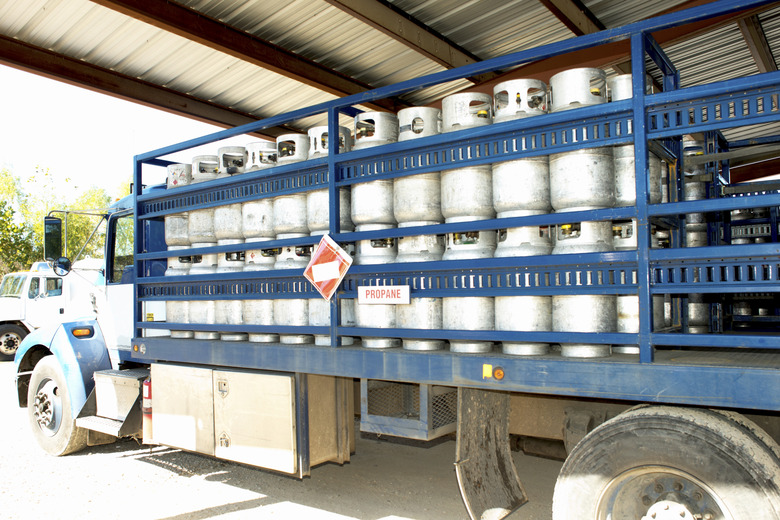How Is Propane Made?
Propane is a fuel that satisfies about 4 percent of the energy needs of the United States, according to the National Propane Gas Association. Propane fuel heats and cools homes, especially in rural areas, and powers vehicles, gas grills and generators, among its many other uses in homes, farms and industry. Propane, a hydrocarbon compound, is a naturally occurring substance found together with natural gas and petroleum deposits. It is isolated as a byproduct of natural gas production and petroleum-refining processes. Propane is a gas at room temperature and atmospheric pressure but changes into a liquid under moderate pressure or low temperatures.
Propane from Natural Gas
Propane from Natural Gas
Propane is extracted from liquid components during natural gas processing. To remove propane from natural gas, hydrocarbons are fractionated and absorbed in oil, which is followed by adsorption to surface-active agents or refrigeration. Hydrocarbons such as butane and propane are removed from natural gas in part to prevent condensation in natural gas pipelines. Unprocessed natural gas consists of about 90 percent methane and only 5 percent propane, but about half of the propane used in the United States comes from natural gas processing. Propane is 270 times denser as a liquid than as a gas, and therefore the extracted propane is stored and transported as a liquid. Because propane is colorless and odorless, an odorant is added for detection.
Propane from Oil Refining
Propane from Oil Refining
At various stages during the oil-refining process, liquefied petroleum gases are produced. Two major constituents of these liquefied gases are butane and propane, which constitute about 1–4 percent of processed crude oil. A major step in the production of propane is fractional distillation under pressure, or stabilization. During this stage, heavier hydrocarbons sink to the bottom, whereas lighter hydrocarbons such as propane are easily removed from the top layer of the mix. The amount of propane obtained depends in part on the type and setup of the oil refinery.
Liquefying Propane
Liquefying Propane
Liquefying propane is critical for storage and transport. If some of the impurities and other hydrocarbons, such as ethane, propene or pentene, are not sufficiently removed, propane will not liquefy properly. Liquefaction must occur at the correct temperature and pressure and must follow the standardized specifications established by the liquefied gas industry. After propane is liquefied, it moves through underground pipelines to storage and distribution stations. Liquid propane remains in large underground tanks or caverns before it is transported by rail, trucks or barges to local propane dealers.
Synthetic Propane and Biopropane
Synthetic Propane and Biopropane
Propane fuel burns more cleanly than gasoline, releasing fewer harmful emissions. Although propane may be a relatively environmentally friendly fuel, it is a fossil fuel and is nonrenewable. Ongoing research is exploring the feasibility of synthesizing or obtaining propane from renewable sources, such as vegetable oil or biomass. Examples of biomass sources are switchgrass, sugarcane and microorganisms. Although the initial production costs may be high, no major modifications to current petroleum-refining processes are required for these new applications and methods. The use of synthetic propane or biopropane should reduce greenhouse gas emissions and increase the energy independence of the United States.
Cite This Article
MLA
Blue, Marie-Luise. "How Is Propane Made?" sciencing.com, https://www.sciencing.com/how-propane-made-4909713/. 24 April 2017.
APA
Blue, Marie-Luise. (2017, April 24). How Is Propane Made?. sciencing.com. Retrieved from https://www.sciencing.com/how-propane-made-4909713/
Chicago
Blue, Marie-Luise. How Is Propane Made? last modified March 24, 2022. https://www.sciencing.com/how-propane-made-4909713/
